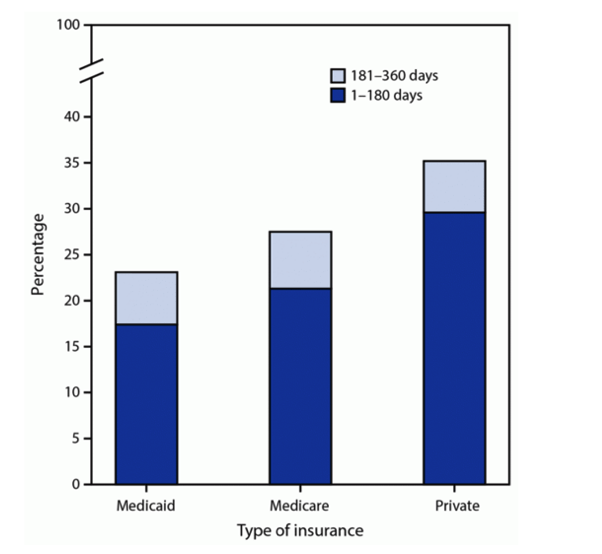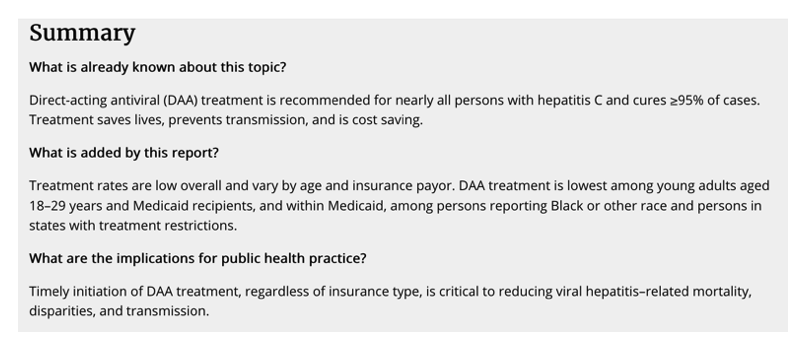| |
30% of HCV+ Adults Start DAAs Within 360 Days - CDC - Low HCV Treatment Rates - Disparities Persist
|
| |
| |
https://www.cdc.gov/mmwr/volumes/71/wr/mm7132e1.htm
The prevalence of DAA treatment initiation within 360 days of the first positive HCV RNA test result among Medicaid, Medicare, and private insurance recipients was 23%, 28%, and 35%, respectively; among those treated, 75%, 77%, and 84%, respectively, initiated treatment within 180 days of diagnosis. Adjusted odds of treatment initiation were lower among those with Medicaid (aOR = 0.54; 95% CI = 0.51-0.57) and Medicare (aOR = 0.62; 95% CI = 0.56-0.68) than among those with private insurance. After adjusting for insurance type, treatment initiation was lowest among adults aged 18-29 and 30-39 years with Medicaid or private insurance, compared with those aged 50-59 years. Among Medicaid recipients, lower odds of treatment initiation were found among persons in states with Medicaid treatment restrictions (aOR = 0.77; 95% CI = 0.74-0.81) than among those in states without restrictions, and among persons whose race was coded as Black or African American (Black) (aOR = 0.93; 95% CI = 0.88-0.99) or other race (aOR = 0.73; 95% CI = 0.62-0.88) than those whose race was coded as White.
FIGURE 1. Percentage of adults with hepatitis C initiating direct-acting antiviral treatment within 360 days of diagnosis, by number of days after diagnosis and insurance type - United States, 2019-2020

Among Medicaid recipients, lower odds of treatment initiation were found among persons in states with Medicaid treatment restrictions (aOR = 0.77; 95% CI = 0.74-0.81) than among those in states without restrictions, and among persons whose race was coded as Black or African American (Black) (aOR = 0.93; 95% CI = 0.88-0.99) or other race (aOR = 0.73; 95% CI = 0.62-0.88) than those whose race was coded as White.
DAA treatment initiation was lowest among adults aged 18-29 and 30-39 years. These groups also have the highest rates of incident HCV infection, often in association with injection drug use, and the largest number of newly reported chronic infections (2). Early hepatitis C treatment prevents disease progression, limits future morbidity and mortality, and reduces health care costs by preventing cases of cirrhosis, liver transplantations, and hepatocellular carcinoma (12-14). Treatment of persons with ongoing transmission risk has important benefits beyond those to the person infected because with each successfully treated person, the number of persons able to transmit disease declines (6).
Medicaid recipients of other races were up to 27% less likely to initiate timely DAA treatment than White Medicaid recipients. The reasons for racial disparities in treatment initiation among continuously enrolled Medicaid recipients are unclear but might involve health system barriers associated with patient access, provider availability, quality of care, patient distrust, stigma, or language and cultural factors (18,19). The provision of culturally competent and timely hepatitis C treatment for racial and ethnic minority groups is essential to reducing existing disparities in hepatitis C-associated outcomes, including higher mortality among American Indian or Alaskan Native, Black, and Hispanic or Latino persons (8.63, 5.44, and 3.84 per 100,000 population, respectively) compared with that among White persons (3.08) (2,11,16,19).
Across insurance types, ≥75% of persons treated initiated treatment within 180 days after diagnosis. The smaller percentage of persons treated within 180 days after diagnosis might indicate lack of access to a hepatitis C treatment provider, insurance denial, or loss to follow-up. Treatment coverage can be increased by providing integrated care, patient navigation, and care coordination (15). The introduction of simplified hepatitis C treatment algorithms reducing the number of laboratory tests and in-person visits can facilitate patient-centered treatment (20).
Medicaid recipients of other races were up to 27% less likely to initiate timely DAA treatment than White Medicaid recipients. The reasons for racial disparities in treatment initiation among continuously enrolled Medicaid recipients are unclear but might involve health system barriers associated with patient access, provider availability, quality of care, patient distrust, stigma, or language and cultural factors (18,19). The provision of culturally competent and timely hepatitis C treatment for racial and ethnic minority groups is essential to reducing existing disparities in hepatitis C-associated outcomes, including higher mortality among American Indian or Alaskan Native, Black, and Hispanic or Latino persons (8.63, 5.44, and 3.84 per 100,000 population, respectively) compared with that among White persons (3.08) (2,11,16,19).
Although marketplace competition has reduced the net cost of DAAs, in 2014 initial costs for a course of all oral treatments exceeded $90,000, resulting in many insurers establishing restrictions to access (14). Current costs are considerably lower; however, Medicaid remains the least likely insurer to cover hepatitis C treatment. Treating all eligible patients without restriction would result in substantially reducing downstream negative clinical outcomes, decreasing the proportion of total costs attributable to future care, and producing considerable cost savings (14). Further, whereas hepatitis C treatment eligibility restrictions have become less stringent in some states, others maintain limitations on access to DAAs, including liver fibrosis qualifications, sobriety requirements, or medical subspecialist prescribing requirements. Removing these eligibility restrictions is necessary, but not sufficient. Addressing other barriers, including burdensome preauthorization requirements as well as integrating routine screening and treatment into primary care and other settings where persons with hepatitis C receive services, could also increase treatment coverage (15-17).
Hepatitis C Treatment Among Insured Adults - United States, 2019-2020
Weekly / August 12, 2022

Abstract
Introduction: Over 2 million adults in the United States have hepatitis C virus (HCV) infection, and it contributes to approximately 14,000 deaths a year. Eight to 12 weeks of highly effective direct-acting antiviral (DAA) treatment, which can cure ≥95% of cases, is recommended for persons with hepatitis C.
Methods: Data from HealthVerity, an administrative claims and encounters database, were used to construct a cohort of adults aged 18-69 years with HCV infection diagnosed during January 30, 2019-October 31, 2020, who were continuously enrolled in insurance for ≥60 days before and ≥360 days after diagnosis (47,687). Multivariable logistic regression was used to assess the association between initiation of DAA treatment and sex, age, race, payor, and Medicaid restriction status; adjusted odds ratios (aORs) and 95% CIs were calculated.
Results: The prevalence of DAA treatment initiation within 360 days of the first positive HCV RNA test result among Medicaid, Medicare, and private insurance recipients was 23%, 28%, and 35%, respectively; among those treated, 75%, 77%, and 84%, respectively, initiated treatment within 180 days of diagnosis. Adjusted odds of treatment initiation were lower among those with Medicaid (aOR = 0.54; 95% CI = 0.51-0.57) and Medicare (aOR = 0.62; 95% CI = 0.56-0.68) than among those with private insurance. After adjusting for insurance type, treatment initiation was lowest among adults aged 18-29 and 30-39 years with Medicaid or private insurance, compared with those aged 50-59 years. Among Medicaid recipients, lower odds of treatment initiation were found among persons in states with Medicaid treatment restrictions (aOR = 0.77; 95% CI = 0.74-0.81) than among those in states without restrictions, and among persons whose race was coded as Black or African American (Black) (aOR = 0.93; 95% CI = 0.88-0.99) or other race (aOR = 0.73; 95% CI = 0.62-0.88) than those whose race was coded as White.
Conclusions and Implications for Public Health Practice: Few insured persons with diagnosed hepatitis C receive timely DAA treatment, and disparities in treatment exist. Unrestricted access to timely DAA treatment is critical to reducing viral hepatitis-related mortality, disparities, and transmission. Treatment saves lives, prevents transmission, and is cost saving.
| |
| |
| |
|
|
|